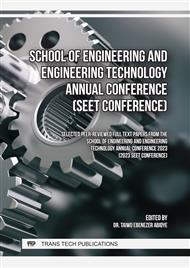[1]
A. J. W. Johnson, B. A. Herschler, A review of the mechanical behavior of CaP and CaP/polymer composites for applications in bone replacement and repair. Acta biomaterialia, 7(1) (2011) 16-30.
DOI: 10.1016/j.actbio.2010.07.012
Google Scholar
[2]
A. Szcześ, L. Hołysz, E. Chibowski, Synthesis of hydroxyapatite for biomedical applications. Advances in colloid and interface science, 249 (2017) 321-330.
DOI: 10.1016/j.cis.2017.04.007
Google Scholar
[3]
N. I. Agbeboh, I. O. Oladele, O. O. Daramola, A. D. Akinwekomi, M. O. Tanimola, O. Olasukanmi, Comparing the effects of two wet precipitation methods on the yield of chicken eggshell-derived hydroxyapatite. Futa J. Eng. Eng. Technol, 16 (2022) 95-104.
DOI: 10.51459/futajeet.2022.16.1.350
Google Scholar
[4]
T. Billiet, M. Vandenhaute, J. Schelfhout, S. Van Vlierberghe, P. Dubruel, A review of trends and limitations in hydrogel-rapid prototyping for tissue engineering. Biomaterials, 33(26) (2012) 6020-6041.
DOI: 10.1016/j.biomaterials.2012.04.050
Google Scholar
[5]
V. Sansone, D. Pagani, M. Melato, The effects on bone cells of metal ions released from orthopaedic implants. A review. Clinical Cases in Mineral and Bone Metabolism, 10(1) (2013) 34.
DOI: 10.11138/ccmbm/2013.10.1.034
Google Scholar
[6]
B. D. Ulery, L. S. Nair, C. T. Laurencin, Biomedical applications of biodegradable polymers. Journal of polymer science Part B: polymer physics, 49(12) (2011) 832-864.
DOI: 10.1002/polb.22259
Google Scholar
[7]
G. M. Raghavendra, K. Varaprasad, T. Jayaramudu, Biomaterials: design, development and biomedical applications. In Nanotechnology applications for tissue engineering William Andrew Publishing. 2015.
DOI: 10.1016/b978-0-323-32889-0.00002-9
Google Scholar
[8]
K. Wang, C. Zhou, Y. Hong, X. Zhang, A review of protein adsorption on bioceramics. Interface focus, 2(3) (2012) 259-277.
DOI: 10.1098/rsfs.2012.0012
Google Scholar
[9]
J. S. Temenoff, A. G. MikosBiomaterials: the intersection of biology and materials science (Vol. 1). Upper Saddle River, NJ, USA: Pearson/Prentice Hall, 2008.
Google Scholar
[10]
D. O. Obada, S. A. Osseni, H. Sina, A. N. Oyedeji, K. A. Salami, E. Okafor,... E. T. Dauda, Hydroxyapatite materials-synthesis routes, mechanical behavior, theoretical insights, and artificial intelligence models: a review. Journal of the Australian Ceramic Society, 59(3) (2023) 565-596.
DOI: 10.1007/s41779-023-00854-2
Google Scholar
[11]
K. J. Burg, S. Porter, J. F. Kellam, Biomaterial developments for bone tissue engineering. Biomaterials, 21(23) (2000) 2347-2359.
DOI: 10.1016/s0142-9612(00)00102-2
Google Scholar
[12]
I. R. Oliveira, T. L. Andrade, K. C. M. L. Araujo, A. P. Luz, V. C. Pandolfelli, Hydroxyapatite synthesis and the benefits of its blend with calcium aluminate cement. Ceramics International, 42(2) (2016) 2542-2549.
DOI: 10.1016/j.ceramint.2015.10.056
Google Scholar
[13]
R. Z. LeGeros, Calcium phosphate-based osteoinductive materials. Chemical reviews, 108(11) (2008) 4742-4753.
DOI: 10.1021/cr800427g
Google Scholar
[14]
D.O. Obada, S.A. Osseni, H. Sina, A.N. Oyedeji, K.A. Salami, E. Okafor, E.T. Dauda, Hydroxyapatite materials-synthesis routes, mechanical behavior, theoretical insights, and artificial intelligence models: a review. Journal of the Australian Ceramic Society, 1-32. (2023)
DOI: 10.1007/s41779-023-00854-2
Google Scholar
[15]
M. A. Adamu, M. Sumaila, M. Dauda, & T. Ause, Production and optimization of novel rice husk ash reinforced polycaprolactone/hydroxyapatite composite for bone regeneration using grey relational analysis. Scientific African, 19 (2023) e01563.
DOI: 10.1016/j.sciaf.2023.e01563
Google Scholar
[16]
X. Zhao, L. Zhang, X. Wang, J. Yang, F. He, Y. Wang, Preparation and mechanical properties of controllable orthogonal arrangement of carbon fiber reinforced hydroxyapatite composites. Ceramics International, 44(7) (2018) 8322-8333.
DOI: 10.1016/j.ceramint.2018.02.020
Google Scholar
[17]
D. Arcos, M. Vallet-Regí, Sol–gel silica-based biomaterials and bone tissue regeneration. Acta biomaterialia, 6(8), (2010) 2874-2888.
DOI: 10.1016/j.actbio.2010.02.012
Google Scholar
[18]
E. S. Akpan, M. Dauda, L. S. Kuburi, D. O. Obada, D. Dodoo-Arhin, A comparative study of the mechanical integrity of natural hydroxyapatite scaffolds prepared from two biogenic sources using a low compaction pressure method. Results in Physics, 17, (2020) 103051.
DOI: 10.1016/j.rinp.2020.103051
Google Scholar
[19]
A. Kusakabe, K. Hirota, T. Mizutani, Crystallisation of hydroxyapatite in phosphorylated poly(vinyl alcohol) as a synthetic route to tough mechanical hybridmaterials. Mater. Sci. Eng. C 70, (2017) 487–493.
DOI: 10.1016/j.msec.2016.09.006
Google Scholar
[20]
D. O. Obada, E. T. Dauda, J. K. Abifarin, N. D. Bansod, D. Dodoo-Arhin, Mechanical measurements of pure and kaolin reinforced hydroxyapatite-derived scaffolds: A comparative study. Materials Today: Proceedings, 38, (2021) 2295-2300.
DOI: 10.1016/j.matpr.2020.06.412
Google Scholar
[21]
T. Wu, J. Su, Y. Li, H. Zhao, Y. Zhang, M. Zhang, B. Wu, Wear resistance mechanism of alumina ceramics containing Gd2O3. Materials, 11(10), (2018) 2054.
DOI: 10.3390/ma11102054
Google Scholar
[22]
S. Kannan, S. I. Vieira, S. M. Olhero, S. Pina, O. D. C. Silva, J. M. F. Ferreira, Synthesis, mechanical and biological characterization of ionic doped carbonated hydroxyapatite/β-tricalcium phosphate mixtures. Acta Biomaterialia, 7(4), (2011)1835-1843.
DOI: 10.1016/j.actbio.2010.12.009
Google Scholar
[23]
G. Anbalagan, A. R. Prabakaran, S. Gunasekaran, Spectroscopic characterization of indian standard sand. Journal of Applied Spectroscopy, 77(1), (2010) 86–94.
DOI: 10.1007/s10812-010-9297-5
Google Scholar
[24]
V. Karageorgiou, D. Kaplan, Porosity of 3D biomaterial scaffolds and osteogenesis. Biomaterials 26 (27), (2005) 5474–5491.
DOI: 10.1016/j.biomaterials.2005.02.002
Google Scholar
[25]
J. Ren, K. Kyohan, K Seock Sam, Jingri Ren, Kyohan Kim, Seock Sam Kim. Fracture and tribological evaluation of dental composite resins containing pre-polymerized particle fillers. J Mater Sci Technol,19(3), (2003) 249e52.
Google Scholar


